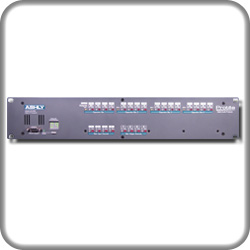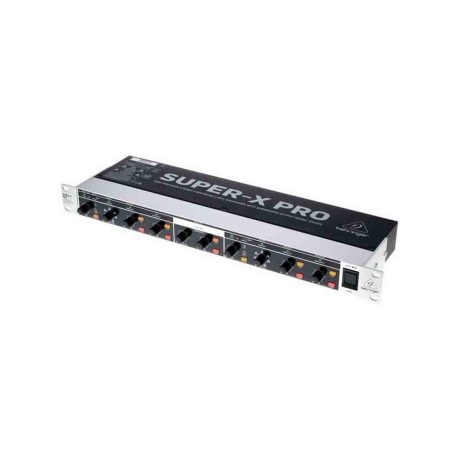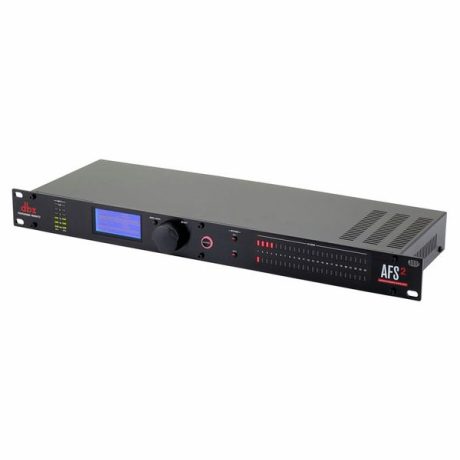| Content |
The Protea 24.24M Matrix Processor uses modular expansion cards to provide up to twenty-four channels of audio matrixing and processing. The base unit offers a four-input/four-output configuration. Each input and output expansion card has an individual DSP processor allowing you to expand the base unit?s total inputs or outputs four channels at a time. These cards are easily installed in the field without the need to reprogram the device. Matrixing allows you to route any input to any output and control individual levels once they have been assigned. Fixed path architecture and extensive processing power per channel will reduce the amount of time it takes to set up your system. All programming is accomplished using Ashly?s Protea System Software on a PC platform. No front panel controls and multi-level software security assures you a tamperproof audio system. Whether you are designing or installing a system for corporate boardrooms, restaurants, courtrooms, houses of worship, left/center/right theatres, auditoriums or conference centers, the Protea 24.24M will more than satisfy your requirements for any zoned system requiring input/output matrixing with signal processing.
The 24.24M Matrix Processor's firmware is supported by flash making the device capable of field upgrades using Ashly Audio?s Protea System Software. Reprogramming is simple and takes only minutes.
Input channel processing blocks include Mic Preamp with Phantom Power, Gain, Delay, fifteen EQ Filters, Gate, Autoleveler and Ducker. Inputs may be configured as either mic or line level. Output channel processing blocks consist of a Cross Point Mixer, HPF/LPF, Delay, fifteen EQ Filters, Gain and Limiter. The cross point mixer in the output section allows you to route any input to any output at any level and mute any input at any output without affecting the true input configuration. The HPF/LPF block offers Bessel, Butterworth and Linkwitz-Riley filters with 12, 18, 24 and 48dB/ octave slopes.
You may use the WR-1, WR-2 and WR-3 to control levels and presets from a remote location. These accessories mount in a standard wall box.
Euroblock connectors for audio, preset recall, dc remote level control and data in/out connections are on the rear panel. Standard 9-pin RS-232 data connectors are located on the front and rear panel to allow all functions to be controlled either by a PC or a dedicated control system.
Thirty-five presets are available to set and store your own system requirements. When using Protea System Software, full system setup and control is quick and easy with the capability of storing multiple system configurations as backups or for future reference.
| Crossover 2-Way stereo or 3-way mono mode Additional subwoofer output Linkwitz-Riley filter with 24 dB / octave Sub-woofer frequency range separately adjustable Individual output gain controls and output mute switch for all bands 2 Balanced XLR inputs with gold-plated contacts 5 Balanced XLR outputs with gold-plated contacts Switchable 25 Hz low-cut filter to protect loudspeakers from infrasound Easy-to-read status LEDs Built-in power supply 100-240V, 50-60 Hz Dimensions (H x W x D): 44 x 483 x 147 mm Weight: 1.6 kg | Digital stereo active crossover with 4 inputs and 8 outputs, incl. software .
- Flexible routing configurations for all standard mono and stereo output operating modes
- 4 analog inputs and 8 analog outputs (XLR)
- Active frequency filter types (Bessel, Butterworth and Linkwitz-Riley) with slopes up to 24 dB/octave split up the audio signal into different frequency bands
- Incl. software editor (for PC and Mac) for remote control via computer through USB interface: store, transfer, and manage your presets
- Up to 30 user presets storable in the device via software
- 5 menu languages selectable (German, English, French, Spanish, Dutch)
- Alphanumeric LCD screen with 2 lines of 16 characters each
- Input sensitivity digitally adjustable
- Inputs and outputs with 4-digit LED level meter as well as clip and limit LED indicator
- Mute switch with LED indicator per output
- 7-band parametric EQ per output
- Up to 7 ms signal delay adjustable for the outputs
- Output limiter with adjustable limits and automatic attack and release settings as overload protection for your amplifying system
- Switchable phase
- Lock function for prevents undesired changes to settings
- Rack installation, 1 U
- Windows XP, Vista, 7, 10 and Mac OS X 10.5.8 and better
- Digital signal processor
- The device can be connected via USB to the PC in connection with DXO Software
The firmware can be updated via the PC connection
- (19") 48.3 cm rack installation 1 U
| Power supply: |
100-240 V AC, 50/60 Hz
6 V DC 800 mA |
| Power connection: |
Mains input via Coaxial power connector (M) power supply cord with AC adapter (provided) |
| Frequency range: |
10 - 22000 Hz |
| THD: |
<0,005 % at 1 kHz |
| DSP: |
Digital signal processor |
| Crossover frequency: |
20-20000 Hz |
| Impedance: |
Input 10 kOhm
Output 50 Ohm |
| Gain: |
Output: -50 dB to +12 dB |
| Filter: |
Linkwitz-Riley; Butterworth; Bessel; 6db/oct; 12db/oct; 18db/oct; 24db/oct |
| Delay: |
0 - 7 ms |
| Dynamic range: |
Input: 114 dB
Output: 110 dB |
| Sample rate: |
48 kHz |
| Connections: |
Input: line via 4 x 3-pin XLR
Output: line via 8 x 3-pin XLR |
| Max. level: |
Input: +22 dBu
Output: +9 dBu |
| USB port: |
Typ B |
| PC connect: |
DXO Software via USB, firmware can be updated |
| Housing design: |
(19") 48.3 cm rack installation 1 U |
| Dimensions: |
Width: 48,3 cm
Depth: 22,3 cm
Height: 4,45 cm |
| Weight: |
1,90 kg |
|
Based on a two-in, six-out topology, the DC-One is designed primarily for users of small-to-medium sized sound systems in both mobile and installed applications. While the unit is an all-new development based on a powerful SHARC processor, it is 100 percent compatible with all settings from other Electro-Voice signal processors. A large part of DC-Oneʼs development was aimed at ensuring that users can easily handle its serious digital horsepower and high-end audio performance. Free. PC-Editor software is available, or the DC-One can be operated via the front panel.
A/D Conversion 24-Bit Delta-Sigma
A/D Conversion 24-bit/sigma-delta (linear phase) 128 times oversampling
Analog Inputs 2 XLR (Electronically Balanced), 2 XLR THRU OUT (Electronically Balanced)
Analog Outputs 6 XLR (Electronically Balanced)
Control Protocol Front Panel USB Connector
D/A Conversion 24-bit/sigma-delta 128 times oversampling
D/A Conversion 24-Bit Delta-Sigma
Data Format 24-Bit
Digital Inputs 1 XLR AES/EBU (2 Ch)
Dynamic Range 111 dB (unweighted, band limited 22 Hz - 22 kHz)
Electronics Type Processor
FIR-Drive No
Frequency Response 10 Hz - 22 kHz (±0.5 dB)
Input Impedance (Balanced) 10 kΩ
Internal Processing 32-Bit Floating Point
Mains Voltage 100-240 VAC
Maximum Input Voltage 8.7 V / +21 dBu (Without -6 dB Analog Pad Engaged)
Maximum Output Voltage 8.7 V / +21 dBu
Nominal Input Voltage 1.23 V / +4 dBu
Nominal Output Voltage 1.23 V / +4 dBu
Output Impedance (Balanced) 50 Ω
Power Consumption 25 W
Sample Rate 48 kHz
THD+N < 0.01% (band limited 22 Hz - 22 kHz)
Height 1RU 44.45 mm (1.75“)
Width 482.6 mm (19“)
Depth 355.6 mm (14“)
Weight Net 4.6 kg (10.14 lbs) |
Providing 48-bit filter algorithms, 24-bit AD/DA conversion and a dynamic range of 115 dB, the DSP 244 sets new standards for digital loudspeaker controllers and processors. The DSP 244 is an universal Digital Sound System Processor that provides 2 inputs and 4 outputs; plus internal summing of the inputs 1 and 2. Via matrix it is possible to assign the outputs to any input or to the sum of the inputs. It is further possible to establish the following configurations: Stereo or Dual 2-Way systems, 3-Way + Direct and 4-Way systems, each with Mono Subchannel, but also full range systems. High and low-pass filters are provided for the frequency crossover functions in all operation modes. The selection includes Linkwitz-Riley, Butterworth and Bessel type filters with switchable slopes between 6, 12, 18 and 24 dB/oct. A huge number of additional filters offers extremely flexible correction of the frequency response. Each input incorporates a 5-band equalizer, allowing to assign high and low-pass, high and low-shelving or parametric peak-dip filters to its individual filter sections. Next to the frequency crossover filters, four additional filters are employed in each output channel, which also can be set to work as high or low-pass, high or low-shelving filters, parametric peak-dip filters, or all-pass filters. Additional filtering is provided through 2. order high-passes for the realization of B-6 alignment, or special LPN-filters (Low-Pass Notch filters) for correcting the frequency and phase responses of optimally vented woofer cabinets. Each channel additionally provides a delay, a polarity switch, a programmable level control and a digital compressor / limiter while the master delays are located in the input channels. Datasheets / ManualsBrochure (309KB)
Mains voltage 90 - 250 V AC / 50 - 60 Hz Power consumption 20 watts Safety class I Inputs 2 x XLR IN, electronically balanced, transformer optional available 2 x XLR OUT (Direct Out) Input voltage (nominal) 1.55 V / + 6 dBu Max. input voltage 24.5 V / + 30 dBu Input impedance 20 kohms Common mode rejection > 40 dB AD-conversion 24-bit, Sigma-Delta, 128 times oversampling, linear phase Outputs 4 x XLR OUT, electronically balanced Output voltage (nominal) 1.55 V / + 6 dBu Max. output voltage 8.7 V / + 21 dBu Output impedance | Advanced Feedback Suppression Processor with Full LCD Display
The AFS2 Dual-Channel Advanced Feedback Suppression Processor from DBX protects your ears and audio equipment from annoying and potentially damaging audio feedback without altering your sound. The AFS2 features application-specific filter types for speech, music low, music medium, and music high. The 24 fixed or live narrow-band notch filters are capable of removing frequencies at 1/80 of an octave, ensuring an optimal frequency response without the possibility of feedback.
The front panel features the wizard function to take the guesswork out of setting up any room by incorporating an advanced feedback suppression module and providing a full LCD display for system settings and menus. Additionally, the AFS2 offers a five-segment LED for accurately monitoring input levels for each channel, while the notch filter indicator allows you to monitor the number of filters applied. Dedicated bypass buttons are included to help isolate problem channels. The rear panel offers XLR and 1/4" inputs and outputs, both switchable between +4 and -10 dB operations. A USB port has been provided for firmware updates. The AFS2 ships with a standard IEC power cable.
| Number of Channels |
2 |
| Inputs |
Connectors: Female XLR and 1/4" TRS
Type: Electronically balanced and unbalanced, RF filtered
Impedance: Balanced 50 kohm, unbalanced 25 kohm
Max Line Level: +20 dBu |
| Input CMRR |
>40 dB, typically >55dB @ 1 kHz |
| Outputs |
Connectors: Male XLR and 1/4" TRS
Type: Electronically balanced and unbalanced, RF filtered
Impedance: Balanced >120 ohms, unbalanced >60 ohms
Max Level: +20 dBu |
| A/D/A Converter |
A/D Converter: DBX type IV conversion system
A/D Dynamic Range: >113 dB A-weighted, >110 dB, unweighted, 22 kHz BW
Type IV Dynamic Range: >119 dB, A-weighted, 22 kHz BW; >117 dB, unweighted, 22 kHz BW
A/D Conversion: 24-bit
Sample Rate: 48 kHz
D/A Dynamic Range: 112 dB A-weighted, 109 dB unweighted
D/A Conversion: 24-bit |
| Dynamic Range |
109 dB A-weighted, 106 dB unweighted, 22 kHz BW |
| THD + Noise |
0.003% typical at +4 dBu, 1 kHz |
| Frequency Response |
20 Hz to 20 kHz, ±0.5dB |
| Crosstalk |
Interchannel Crosstalk: >80 dB typical
Crosstalk Input to Output: >80 dB |
| Power |
US: 100 to 120 VAC 60 Hz
EU: 220 to 240 VAC 50 Hz
9 W |
| Dimensions (HxDxW) |
1.8 x 5.8 x 19.0" / 4.4 x 14.6 x 48.3 cm |
| Weight |
4.5 lb / 2.0 kg |
|

















Reviews
There are no reviews yet.